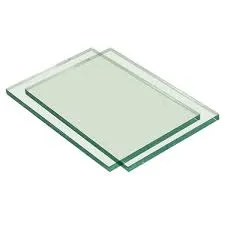The Difference Between Tempered Glass and Normal Glass
When it comes to choosing glass for various applications, understanding the differences between tempered glass and normal (or annealed) glass is crucial. Both types of glass have distinct properties that make them suitable for different uses. In this article, we will explore the key differences between these two types of glass, their manufacturing processes, structural integrity, thermal resistance, safety considerations, and common applications.
Manufacturing Process
Normal glass, also known as annealed glass, is made by heating raw materials like silica sand, soda ash, and limestone in a furnace until they melt. The molten glass is then cooled slowly in a controlled environment to relieve internal stresses, resulting in a smooth and uniform sheet of glass. This process allows for relatively low production costs but leaves the glass more susceptible to thermal and physical stresses.
In contrast, tempered glass is manufactured through a process called tempering. After the glass is cut to size, it is heated to a temperature of approximately 620°C (1,148°F) and then rapidly cooled. This process, known as quenching, increases the surface compressive strength of the glass while simultaneously relieving internal stresses. As a result, tempered glass is significantly stronger than normal glass, making it a preferred option for many safety applications.
Structural Integrity
One of the most notable differences between tempered glass and normal glass is their strength. Tempered glass is approximately four to five times stronger than standard glass of the same thickness. This increased strength is particularly important in applications where the glass is exposed to high impacts or stresses, such as in shower doors, glass facades, and balustrades.
Normal glass can break into many sharp pieces, posing a safety hazard. In contrast, tempered glass shatters into small, blunt pieces that are less likely to cause injury. This characteristic makes tempered glass an excellent choice for environments where safety is a concern, such as in homes, commercial buildings, and vehicles.
Thermal Resistance
what is the difference between tempered glass and normal glass
Another significant distinction between the two types of glass is their thermal resistance. Normal glass is susceptible to thermal shock, which can occur when it experiences sudden temperature changes. For example, if a cold object is placed on a hot normal glass surface, it may crack or break due to the stress caused by the temperature difference.
Tempered glass, on the other hand, is designed to withstand larger temperature variations. Its manufacturing process enables it to tolerate thermal shock better than normal glass, making it more suitable for applications involving heat, such as oven doors or glass partitions near heat sources.
Safety Considerations
When considering safety, tempered glass stands out as the clear winner. Its shattering characteristics and higher strength make it the glass of choice in environments where safety is paramount. This includes applications like glass doors, windows in high-rise buildings, and even automotive windows. The ability of tempered glass to fail safely is a significant factor in its widespread use in public spaces.
Common Applications
Normal glass is commonly used in standard windows, picture frames, and where safety is not a primary concern. Its affordability makes it a go-to option for many residential projects. However, in scenarios where safety, strength, and thermal resistance are critical, tempered glass is preferred. Common applications include
- Shower enclosures
- Glass doors
- Windows in commercial buildings
- Glass partitions
- Automotive windows
- Glass facades
Conclusion
In summary, the choice between tempered glass and normal glass largely depends on the specific requirements of the project at hand. While normal glass may be adequate for some applications due to its lower cost, tempered glass offers greater strength, safety, and thermal resistance, making it a superior choice for many uses, especially in environments where durability and safety are paramount. Understanding these differences can help individuals and businesses make informed decisions when selecting glass for their needs.
 Afrikaans
Afrikaans  Albanian
Albanian  Amharic
Amharic  Arabic
Arabic  Armenian
Armenian  Azerbaijani
Azerbaijani  Basque
Basque  Belarusian
Belarusian  Bengali
Bengali  Bosnian
Bosnian  Bulgarian
Bulgarian  Catalan
Catalan  Cebuano
Cebuano  Corsican
Corsican  Croatian
Croatian  Czech
Czech  Danish
Danish  Dutch
Dutch  English
English  Esperanto
Esperanto  Estonian
Estonian  Finnish
Finnish  French
French  Frisian
Frisian  Galician
Galician  Georgian
Georgian  German
German  Greek
Greek  Gujarati
Gujarati  Haitian Creole
Haitian Creole  hausa
hausa  hawaiian
hawaiian  Hebrew
Hebrew  Hindi
Hindi  Miao
Miao  Hungarian
Hungarian  Icelandic
Icelandic  igbo
igbo  Indonesian
Indonesian  irish
irish  Italian
Italian  Japanese
Japanese  Javanese
Javanese  Kannada
Kannada  kazakh
kazakh  Khmer
Khmer  Rwandese
Rwandese  Korean
Korean  Kurdish
Kurdish  Kyrgyz
Kyrgyz  Lao
Lao  Latin
Latin  Latvian
Latvian  Lithuanian
Lithuanian  Luxembourgish
Luxembourgish  Macedonian
Macedonian  Malgashi
Malgashi  Malay
Malay  Malayalam
Malayalam  Maltese
Maltese  Maori
Maori  Marathi
Marathi  Mongolian
Mongolian  Myanmar
Myanmar  Nepali
Nepali  Norwegian
Norwegian  Norwegian
Norwegian  Occitan
Occitan  Pashto
Pashto  Persian
Persian  Polish
Polish  Portuguese
Portuguese  Punjabi
Punjabi  Romanian
Romanian  Russian
Russian  Samoan
Samoan  Scottish Gaelic
Scottish Gaelic  Serbian
Serbian  Sesotho
Sesotho  Shona
Shona  Sindhi
Sindhi  Sinhala
Sinhala  Slovak
Slovak  Slovenian
Slovenian  Somali
Somali  Spanish
Spanish  Sundanese
Sundanese  Swahili
Swahili  Swedish
Swedish  Tagalog
Tagalog  Tajik
Tajik  Tamil
Tamil  Tatar
Tatar  Telugu
Telugu  Thai
Thai  Turkish
Turkish  Turkmen
Turkmen  Ukrainian
Ukrainian  Urdu
Urdu  Uighur
Uighur  Uzbek
Uzbek  Vietnamese
Vietnamese  Welsh
Welsh  Bantu
Bantu  Yiddish
Yiddish  Yoruba
Yoruba  Zulu
Zulu 

